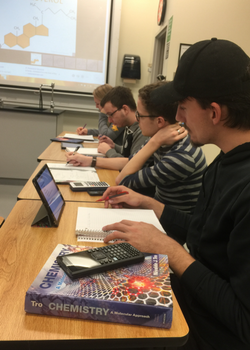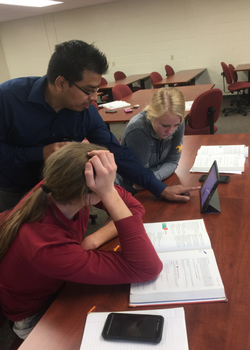LAMP FELLOWS OF THE MONTH (January, 2018)
Dr. Dinesh Kasti and Dr. Sridhar Budhi, faculty at Eastern Wyoming College (EWC) in
Torrington are the LAMP Fellows of the Month for January. Dr. Kasti and Dr. Budhi
avidly seek opportunities to learn more about teaching and to improve the experience
of and opportunities for EWC students. Their participation in the LAMP Summer Institute
and ensuing workshops has exemplified this engagement and most recently both of these
dedicated faculty members have volunteered to serve on the long-term steering committee
for LAMP. 
Dr. Sridhar Budhi’s philosophy of teaching allows him to freely share his passion for Chemistry with his students. Sridhar says, “…it is very important before teaching any new concept, to initiate a discussion among students and emphasize: 1) why it is important to study that concept and the challenges we must face when we don’t know it; 2) what the concept taught us, and finally; 3) how it transforms our day‐to‐day applications – real life connections.”
The instructional plans developed by Dr. Budhi during his summer involvement in LAMP align with this philosophy as they state outcomes that assess high level thought, communication and collaboration skills. He uses a full spectrum of active learning techniques, ranging from think-pair-share to problem-based learning, in order to facilitate development of these skills.
I visited Sridhar’s classroom at Eastern Wyoming College on Friday the 13 th. And perhaps the scariest moment was when I realized that the clock did not tell time but instead it told periodic elements: Mg (12), H (1), He(2), Li(3), Be(4), B(5), C(6), N(7), F(8), Ne(10), Na(11).
He began by telling the students that he had graded the exams and that they had the opportunity to fix their exams. He emphasized that it is about the learning and growth mindset. Instead of a lecture projection, each student had an iPad. On the iPad, he uses Nearpod to display slides and the first one is about Mindset. The quote he called to attention first ways, “Excellence is not a skill; it is an attitude.”
“And now, let’s return to our discussion of chirality”, said Dr. Budhi. On the iPad there appeared a large molecule – morphine. We were asked to first label the chiral carbon centers and then identify the chiral carbon. I admittedly felt that familiar surge of excitement as I located all the familiar functional groups and after a bit of deep looking, I found the chiral carbon. The students circled these on the iPad and then hit ‘submit’. On my iPad, I could see each of the student’s work. Sridhar talked through the examples and non-examples. The students discussed with each other and found additional chiral carbons. The next molecule to appear was cholesterol. The students practiced again.
This atmosphere of safe failure and growth mindset abounded in Sridhar’s classroom! He would say, ““Doing mistakes is not a shameful act.” “Please never be afraid of participating.” And the magnificent thing was that the students did not seem afraid.
Perhaps the real fright of my Friday, the 13th visit to EWC was actually the acknowledgement of the teaching load for which Dr. Budhi and Dr. Kasti are responsible. They often teach 15 credit hours and while their student numbers are low, they often move directly from one class directly to the next. Thus, as soon as I completed my observation of one of Dr. Budhi’s classes, he practically ran through the hallways to deliver me to Dr. Kasti’s course. But the stress of the rush was tempered by the thoughtful pace of student-driven learning facilitated by Dr. Kasti.

“As usual let’s begin with the question you have from the homework,” stated Dinesh. He compiled a list on the board of questions that the students shouted out: 33, 47 and 43. He had the students work through a similar question. He gave them 3 minutes and helped them work through it.
“What percent greater was the # of visitors to Yahoo than to Wikipedia? There were 150 more visitors to Yahoo. How do we convert this to percentages?”
He wrote on the board 150/out of what?
“You have to put something into the denominator.”
They moved onto another example.
“Just tell me when I’m wrong.” – one of the more eager students said.
Dinesh emphasized again and again how to determine what was in the denominator. He mentioned that the students simply needed more practice and he noted that they would be given that chance.
The class moved on to interest. He broke the topic down into simple interest & compound interest. He split the students into groups and passed out iPads. Using mediaplayer from the Pearson textbook company, the students first watched an example problem. The students could stop, pause and replay examples. One aspect of each example was that they showed the students how to enter the problem into their calculator. When the students had worked through the iPad problems, Dinesh had them work on a sample book problem. This work was more individual.
As I observed Dr. Kasti’s classroom, I recalled how well it aligned with the Instructional Plan that he wrote after his participation in the Summer Institute. This plan was guided by a holistic approach that values all qualities necessary for good instruction. In his Instructional Plan, Dinesh writes:
Any new lesson should begin with a good motivation behind that topic. The real motivation for a student to learn Math or Statistics comes when they actually see how Math and Statistics can be used to solve so many real world problems that they themselves are seeing or anticipating to see, which may have originated from the realm of Economics, Business, Biology, Physics, Chemistry, Psychology or virtually any other Field. So, I usually begin a topic in Math or Statistics by giving students a glimpse of how that topic is being used in solving some real world problems. This instantly catches students' attention making them completely prepared to dive into the active learning process for that topic.
Dr. Kasti’s learning outcomes align with this philosophy as they seek to assess students’ motivation to learn math, their affective engagement in the process, their ability to cooperate, problem-solve and participate. While one day in Dinesh’s classroom gave me a view of the spectrum of active learning techniques that he uses, I realize that I glimpsed only some of the many pedagogies of engagement that he employs.
After being a part of the LAMP Summer Institute, Dr. Budhi and Dr. Kasti both express invigorating changes in their teaching. However, they both model growth mindset and look forward to being life-long learners of teaching and learning!
- Rachel Watson, 1/25/18

